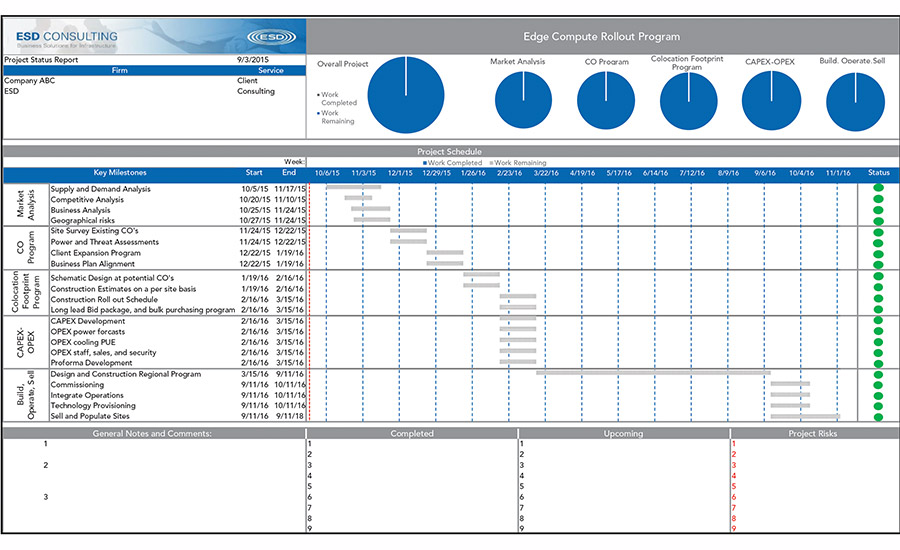Speed to market for technology roll-outs has become one of the greatest challenges the CIO faces today. Competition, market positioning, scheduling, and technology limitations all play an obstacle for fast roll-out projects. Within the last three years, technology growth is outpacing the capability of IT organizations to execute implementation internally and externally. By the time an organization is trained in the latest technology that was just recently purchased, an upgrade is released or even worse a new technology trumps the one that was just implemented. Within this column, I’d like to discuss how the design/construction industry mirrors the CIO technology roll-out program and the integration of both activities.
THE TECHNOLOGY ROLL-OUT PROGRAM
It starts with a vision and then is quickly driven to reality. The vision of GPS originally started approximately 20 years ago, and was driven by Google Maps, and then through satellite technology created for Google Earth. While the vision at the time seemed unreachable, through funding and commitment it became a reality and now has expanded way beyond the application, touching the day-to-day lives of each and every one of us. While most of us are not challenged by this level of vision, we are challenged every day on a smaller level. Much of the time a CIO is rolling-out a new application or service (internally or externally) and the infrastructure often lags to support the technology. Let’s look at edge-compute for an example.
In theory “real-time applications” can only be achieved through synchronous processing, which we all know because distance limitation is not a reality — it’s more of an oxymoron. However, we did not think that the cell phone of yesteryear would have the capabilities it has today. There are several industries that would like to go to real-time, most significantly the gaming industry. This is why Comcast, Sony, and others are developing distributed data centers across the nation in highly populated cities. While “real-time” is still not achieved, latency concerns are better than processing out in a corn field. Trading has been striving towards “real-time” for years, hence proximity to exchanges is of value. However, most CIOs are not driven towards an expensive rollout that requires construction. In most cases, such as Netflix, colocation data centers with access to large amounts of bandwidth seem to suffice.
THE INTEGRATION OF A TECHNOLOGYROLL-OUT AND CONSTRUCTION
Many colocation providers are looking into edge-compute as a method to attract CIOs and endusers. However, colocation facilities are often not by a telecom central office (CO). The CO network is the closet connection to long-haul fiber, and is an ideal location for server connectivity. This model holds true also with the DRT/Telx model often connected to carriers (such as in 350 Cermak, Chicago). However, throughout the wholesale/colocation market, telecom providers have the best opportunity to roll out edge compute data centers. Here is a look at an integrated program for telecom companies to develop edge compute facilities.
• Step 1: Develop a market analysis to include supply and demand, competitive analysis, business analysis, and geographical risks
• Step 2: CO program that incorporates site surveys of existing COs or data centers, power-fiber-threat assessments, client expansion program, and business plan alignment
• Step 3: Colocation footprint program, schematic design, construction estimates on a per-site basis, construction roll out and schedule, and long lead bid packages
• Step 4: CAPX-OPEX program, power forecast, PUE, OPEX staff (security, maintenance, operations), pro forma development
• Step 5: Build-Sell-Operate; commissioning, integrate operations, technology provisioning, sell, and populate
THE CIO TECHNOLOGY ROLL-OUT PROGRAM
While the above edge-compute roll-out program is being designed and constructed, CIO technology implementation takes a similar process. During the “vision” process, a full program for the CIO needs to address total cost of ownership (TCO) for the following:
• Step 1: Needs analysis, benefit analysis, application development, geographical strategy of deployment, initial cost analysis, and overall program schedule
• Step 2: Programming, applications testing, gap analysis, security design, private cloud program, and procurement program
• Step 3: Infrastructure program: edge-compute provider, site selection, contracts (leasing), cloud infrastructure development, and cost pro forma
• Step 4: Implementation: server installation, connectivity installation, burn-in, and testing
• Step 5: Ongoing operations: help desk support, facility maintenance, software maintenance
INTEGRATED ROLL-OUT TCO
The key component of a new technology roll-out program is to develop the overall TCO for the entire roll-out. The TCO should include all levels of the application development and installation as well as the facility infrastructure to support the new application/program. An integrated TCO focuses on startup cost, implementation, and ongoing operations covering a variety of OPEX components. When planned properly upfront, risk is mitigated and costs are benchmarked after completion to cross reference the next roll-out program concerning your new application.




